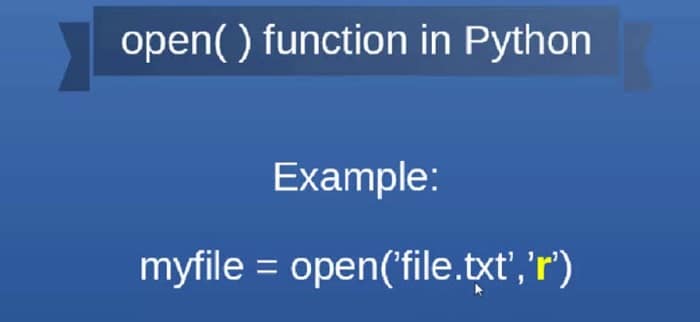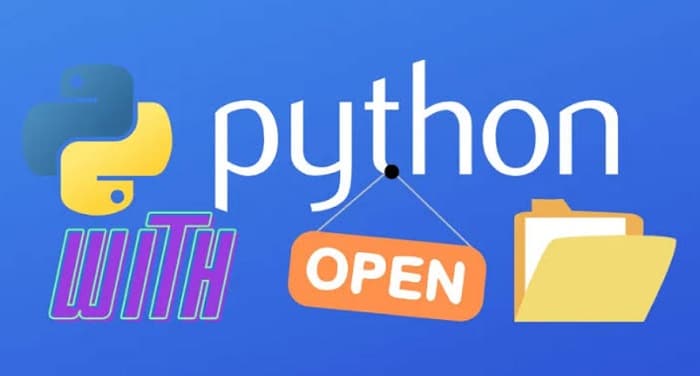Python is the best coding language for beginners – easy to pick up and implement. The vast number of frameworks and libraries with Python is impressive and especially useful in machine learning and data analytics.
Python is also an interpreted language rather than compiled, which allows easy identification of runtime error sources. The considerable flexibility that Python offers users is genuinely one of a kind.

Today’s article will demonstrate using Python’s ‘with open’ Statement.
See Also: How To Fix SyntaxError’ Unexpected EOF’ While Parsing
Table of Contents
Python “open” Statement
The ‘with open’ is technically an extension of the ‘open’ Statement, both used for file handling in a Python environment. File handling is creating, deleting, and storing files, with updating and editing as required.

To work with a file within Python, opening it is the first step. And that is precisely what the open Statement does- it opens the file.
For instance, let’s say we have a text file saved under the name ‘hello.txt’ and we have the following lines of text in it:
“Good morning everyone.
I hope everyone has a good day ahead.”
To open it in Python, we must first declare a variable for the function. For example, ‘my_file’. This variable will allow us to access the file and call different parts upon it when required.
my_file=open(‘hello.txt’,’ r’)
Parameters In “open” Statement
The open Statement takes several parameters, but the most important is the filename, which we have provided as ‘hello.txt,’ and the mode we supplied as ‘r’. The other parameters are optional. For example:
- ‘Encoding’ is used to specify the encoding, and
- ‘Buffering’ is used to set the buffering policy.
The above parameters are optional, and we do not require to specify these for the functioning of the open Statement.
Modes In “open” Statement
There are quite a few modes:
- ‘r’ or ‘read’ mode is the default one.
- ‘w’ or the ‘write’ mode for entirely overwriting text documents.
- ‘x’ for exclusive creation and opening of a file.
- ‘a’ for appending into a file.
- ‘b’ for specifically opening a binary file, and so on.
Python Syntax For Reading and Closing A File

After opening a file, we pass a print function “to read” and output the file content.
my_file=open('hello.txt',' r')
print(my_file.read())
After opening and reading our file content, we need to close it. Closing a file is particularly mandatory, as failure to do so can result in loss of data and corrupted files.
my_file=open('hello.txt',' r')
print(my_file.read())
close.my_file()
Now that our file is closed and safe, here is the output:
[“Good morning, everyone.Hope everyone has a good day ahead”].
Similarly, if we want to ‘write’ or overwrite the file, our code will look like this:
my_file= "open('hello.txt',' w')
my_file.write("Yes, we are good")
print(my_file.readlines())
my_file.close()
The ‘readlines’ function returns the file’s content as string elements of a list.
So the output will be:
Python “with open” Statement
Now coming to our subject for the day, the ‘with open’ Statement functions the same as the ‘open’ function. Unlike the open Statement, the difference is that we don’t have to close the file explicitly with this function. This allows for hassle-free code writing, making the code look cleaner and much more compact.

It might not be apparent with just three lines of code, as illustrated here, but when programmers have to deal with thousands of lines of code, it is common to forget about closing the hundreds of files after opening them. Thus, the ‘with open’ Statement is a much better practice.
The parameters of the ‘with open’ function remain the same as the’ open’ function. Filename and mode are the only two that we use here.
To carry on with the example, if we want to read the file as before, the syntax will be:
my_file = with open(‘hello.txt’,’r’) print(my_file.read())
And that is it. We don’t have to add another line of code to close the file. The output would be:
[“Yes, we are good”].(Remember we overwrote the initial file)
To overwrite again, this time using the ‘with open’ Statement,
my_file= open('hello.txt',' w')
my_file.write("Can we meet for coffee,"" Tell me a good time")
print(my_file.readlines())
As expected, we will get an output as string elements of a list:
[“Can we meet for coffee,”” Tell me a good time”]See Also: How To Fix Python NameError If Not Defined
FAQs
How Does Open () Work?
By establishing a link between a file and the descriptor, the open() function works. It must also produce a file descriptor referencing a file and an available file description linking to that file. However, other I/O functions use the file descriptor to refer to a file.
How Do I Open A Python Module?
In Python, the import statement helps to open modules. Hence, doing this allows you to run the module's code while maintaining the definition scopes so your current file or files can utilize them.
What Is A File In Python?
A collection of data or information kept on a computer is a file. Among the many file types, you are used to are text, audio, and online videos files. Hence, Python makes it simple to change these files. Text and binary files are the two main types of files.
What Does A List In Python Mean?
A list is an element-changing ordered sequence in the Python programming language. A list also has any elements or values present within it. You can also define lists by having values inside square brackets, much as characters inside quotations define strings.
What Is An Array's Function In Python?
An array is a fundamental data structure with a significant function in most programming languages. They are multi-item containers in the programming language of Python. Furthermore, they consist of a collection of ordered items whose values are all the same data type.
What is the use of With open statement in Python?
The ‘with open‘ statement is an extension of Open() statement in Python. It is generally usable for creating, storing, and deleting files. With statement works with open() function in order to open your Python file. However, while open () needs the close() function for Python to close files, with open statement closes the file without the need for an additional function.
What are the steps to open file using with open statement?
In order to open a file in Python using with statement, you need to use the syntax: with open('example. txt', 'w') as file: file. write('Hello World!'). After Python opens the file, it assigns a file pointer to the variable MyFile. Therefore, you can use read and write operations using MyFile object. Remember to check for syntax errors.
Is open () a function in Python?
Yes, open() is a function in Python. The open() function is for opening Python’s internally stored files. When you use the open() function, the file you open is returned as a file object. The correct syntax for the open() function is my_file=open(‘hello.txt’,’ r’). You must ensure that the statement does not have any syntax errors.
What is a Python with statement?
The with statement is a statement Python uses for exception handling. It is also usable for managing resources. This statement helps make the code easily readable and cleaner. Additionally, it simplifies the management of resources. In this statement, a simple shorthand replaces a try-catch block. It also ensures that any resources in Python close after completed processing.
What does read () do in Python?
The read() method in Python generally helps you read the contents of your file. The function reads a specified number of characters in your file. Alternatively, you can also use read() to read an entire file. The output for read() is a string. The correct syntax for read() method is file_object. read(n). You must enter the parameters correctly.
Conclusion
So, this is how a very basic ‘with open’ statement functionsPythonthon. The optional parameters can be specified and experimented with to fine-tune the function per our needs further.
See Also: How To Use Atom For Python? Complete Guide